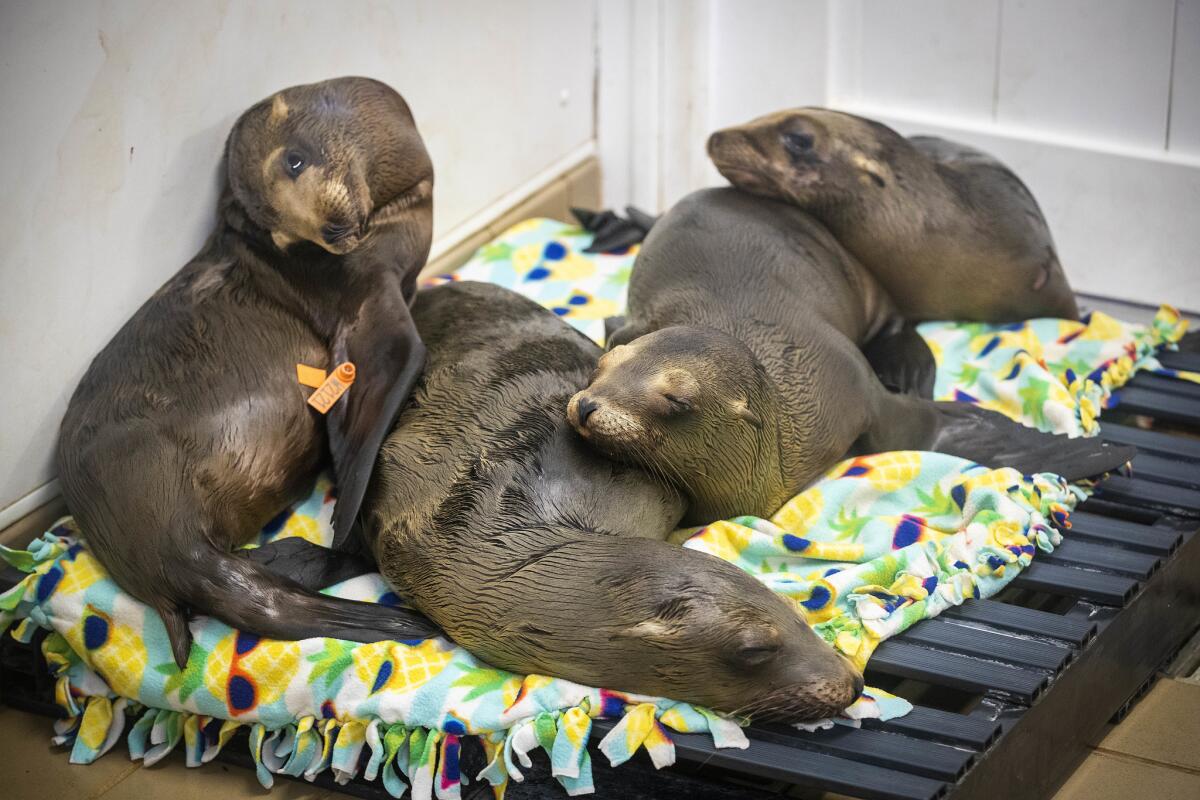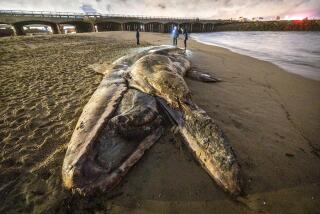Must Reads: Sick marine mammals turning up on California beaches in droves

Marine animal rescue organization overwhelmed by high number of sea lions.
The deep blue waters and crashing waves along the coast of California provide a picturesque backdrop to the state’s shores, but the sight has been marred of late.
As winter rains have poured down, trash has flowed onto area beaches. And amid the detritus has been an even more troubling discovery: scores of sickened or dead marine mammals.
Worse yet, the sick animals seem to be concentrated locally.
While Northern California and San Diego County have seen dozens of stranded sea lion pups, rescuers say the numbers are normal for this time of year for their areas.
But Orange County beaches have been inundated with sick seals, sea lions and other marine mammals, as well as dead dolphins.
Rescues of unhealthy marine mammals have nearly tripled for this time of year in Orange County, according to the Pacific Marine Mammal Center, which this week took in its 41st animal since the year began. The number of sick marine mammals becoming stranded in L.A. County beaches is slightly higher than usual, with 44 being cared for by the Marine Mammal Care Center Los Angeles, said veterinarian Lauren Palmer.
“It’s been a little bit of a whirlwind,” said Krysta Higuchi, a spokeswoman for the Pacific Marine Mammal Center in Laguna Beach. “We’re going through fish, funds and medical supplies faster than we expected. It is a strain on all of us here.”
The center says it’s normal for the number of stranded animals to go up near the end of March, but this year the organization has rescued three elephant seals and a large number of sea lions much earlier than usual, and most are 8-month-old pups.
Sea lion pups are typically beached either because their mothers are unhealthy and cannot properly feed them, or they were strong enough to wean early and then are unable to find food on their own, said Sharon Melin, a wildlife biologist with the National Oceanic and Atmospheric Administration.
The rescued pups have been dry, malnourished and emaciated, weighing half as much as they should, the center said.
Though the exact reason for the increase in the number of strandings this year is unknown, Higuchi said it could be tied to warmer ocean waters caused by an El Niño weather pattern or excess stormwater runoff from this winter’s rains.
After months of flirting, conditions for El Niño came together in the central Pacific in mid-February, but forecasters say the pattern is weak.
For an El Niño to be declared, a certain atmospheric circulation pattern has to form over warm ocean-surface temperatures. The ocean temperatures have been elevated for months, but the circulation pattern hadn’t caught on until last month, said Michelle L’Heureux, a meteorologist with the National Weather Services’ Climate Prediction Center.
Warm waters often reduce the amount of bait fish in the ocean, such as sardines and anchovies, which larger marine mammals eat. The smaller forage fish tend to swim in cold water, so during an El Niño event the fish may be diving deeper or farther out than usual — out of the reach of young sea lions, said Melin, who studies the overall population of sea lions in the state.
She recently returned from a trip to the Channel Islands and found a strong population of healthy sea lion mothers, which seems to indicate the newly weaned pups aren’t finding enough food, leading to their strandings.

In addition to the higher-than-normal pinniped rescues, researchers are seeing an increase in the number of stranded dolphins.
The Pacific Marine Mammal Center recently enlisted the help of NOAA and several universities to help determine why so many dolphins have washed up along the state’s beaches.
Last month, 20 dead dolphins were found along the California coast, a much higher number than experts have seen compared with previous years, said Justin Viezbicke, a stranding coordinator with NOAA. That’s higher than the total number of dead dolphins found statewide in 2017 and 2018 combined.
In Orange County, 10 dolphins have been found dead or dying since the beginning of the year — four in the last week. In Los Angeles County, two dying dolphins were found stranded on beaches, a “very unusual” count for the area so early in the year, according to the Marine Mammal Care Center Los Angeles.
Reports of the stranded dolphins and sea lion rescues have come as the state is experiencing an unusually wet year, with consecutive storms washing trash and toxins into the ocean.
Necropsy results have yet to come in, but Viezbicke thinks the dolphin beachings have something to do with this year’s rain, which has pounded the state in recent months with a series of atmospheric river-fueled fronts.
It’s possible the storm runoff that washes waste into the ocean has caused a stronger bloom of poisonous algae, which produce a toxin responsible for neurological disorders, Higuchi said. Sickness caused by the algae blooms can cause seizures, which affected three of the dolphins found recently in Southern California.
“They were flailing around” when rescuers arrived, Higuchi said. “It was a very heartbreaking experience. These dolphins are such majestic creatures. To see them suffering was very difficult.”
Whale-watching groups have reported an unusually high number of dolphins along the coast this season. Rather than any unusual illnesses, it’s possible onshore winds and waves from strong storms could be washing the carcasses ashore, making the dead animals more visible, Viezbicke said.
But as to why there are so many stranded sea lions this winter, the answers are less clear.
“It’s getting hard to give good answers because the ocean is getting more unpredictable,” said Douglas McCauley, a professor of marine biology at UC Santa Barbara. “The ocean is just getting weirder. So much is changing” in terms of climate.
Although the El Niño conditions are weak, McCauley says the weather pattern may be throwing the ocean temperatures off just enough to affect marine life.
The Orange and Los Angeles county coasts tend to see stranded sea lion pups sooner than other parts of California because the animals breed at the nearby Channel Islands, Melin said.
During the same two-month span in 2018, the Pacific Marine Mammal Center rescued 15 animals, compared with 41 from this year, said Peter Chang, the center’s chief executive. In 2017, the group had rescued 18 pinnipeds by this time of the year.
The Sausalito-based Marine Mammal Center — a separate entity from the Pacific Marine Mammal Center that rescues animals on 600 miles of beaches between Mendocino and San Luis Obispo counties — has not seen an uptick in rescues this winter, spokesman Giancarlo Rulli said. The organization is currently housing 18 marine mammals, a normal number for this time of year, he said.
“There’s been nothing out of the ordinary, but things could change,” Rulli said. “That could mean something could head up the coast. We’re keeping a close eye on things.”
To the south, SeaWorld in San Diego has also seen an average number of rescues, with a total of 45 sea lions, spokesman David Koontz said.
The last time California had a major increase in stranded sea lions was between 2013 and 2016, when a strong El Niño caused what experts called an “unusual mortality event.”
In 2015, the Pacific Marine Mammal Center rescued nearly 600 animals, while the Marine Mammal Center in Northern California rescued 1,800.
After 2016, the sea lion population began to recover, but Melin said she expects there will be more large mortality events, given the changing climate.
Though El Niño leads to temporary shifts in marine mammals’ movements and population, general ocean warming is causing more permanent damage to all sorts of sea creatures.
In February, UC Santa Barbara researchers found an elusive hoodwinker sunfish that had washed ashore in Goleta, far from its usual home in the waters of Australia and New Zealand. Last week, a dead humpback whale ended up in Brazil at the mouth of the Amazon River.
“The waters we’ve seen in the last decade are probably what we’ll be seeing in the future,” Melin said. “It will be more common for large stranding events. We’ve seen it coming, really.”
alejandra.reyesvelarde@latimes.com
Twitter: @r_valejandra
More to Read
Start your day right
Sign up for Essential California for news, features and recommendations from the L.A. Times and beyond in your inbox six days a week.
You may occasionally receive promotional content from the Los Angeles Times.







